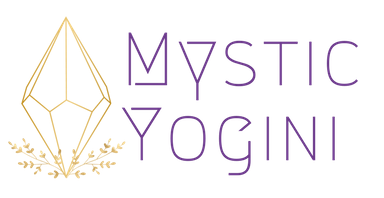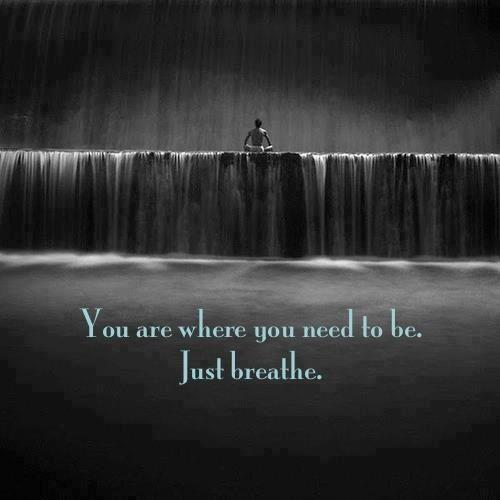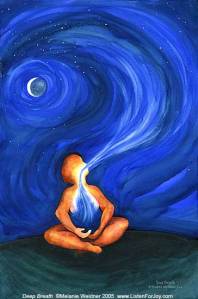“The breath is a fundamental tool for the Kundalini Yoga student. Master of the breath is a foundation for:
– Promoting health and vitality
– Opening the range and creativity of the emotions
– Controlling the moods
– Developing concentration
– Promoting a feeling of connectedness”
~ The Aquarian Teacher Level One Instructor Textbook by Yogi Bhajan, PHD, Pg 90 ~
I learned something really cool the other day in KYTT. I learned a couple of intriguing things actually during our weekend talking about the breath in yoga that I want to share with you.
First, I have a habit of breathing backwards. How crazy is that!? I breathe, probably like most people, without thinking. Despite me having meditated for years paying attention to the breath I didn’t realize that I breathe backwards more often than not.
According to the teachers at Yoga West this is actually a very common problem, as is shallow breathing (I’m at fault for this, too). Backwards breathing refers to inhaling the breath while compressing the stomach (diaphragm) and exhaling while expanding the diaphragm area.
It doesn’t make sense. In our yoga practice we are supposed to use the breath to harness certain energies and to stimulate a particular flow of energy. We use the breath to shift blockages, pain and even illness from our bodies.
If we aren’t breathing correctly then our practice doesn’t reap all the benefits it could have. On top of that, unconsciously breathing backwards can cause other challenges to arise in our life. It takes away the power from our words since we aren’t speaking from our Navel Point. It creates a smaller lung capacity simply because we aren’t breathing in large amounts of air. It creates more stress on our body.
Our breath is shallow when we breathe backwards, too, which affects us on all levels from the mind being more chaotic because the mind follows the breath to us not refuelling the cells throughout our whole body with oxygen to retaining more pain and stress than we need to.
It’s super crazy. In my personal life I have been a big fan of using the breath in energy work. I often use the breath to shift energy and pain inside my body or a clients. I’ve become pretty effective at breathing into a pain and releasing it simply using a combination of breath and visualization.
I also regularly use the breath to reduce my anxieties and general overwhelm of the world around me. I discovered that by breathing when my shoulders go up I can release the tension that ages me and causes reactions instead of responses to situations.
I’ve noticed that over the years I’ve become a more steady person able to to weather more things. Bigger cities. Groups of people. Parties. Unfamiliar homes. Odd situations. Situations that require me to speak truth. I always go back to the breath though when I’m beginning to freak out about something. I breathe to figure out what I need to do.
And now I have a new level of awareness about my breath. I’ve been watching it for a few days after the class, checking in with myself at random times, and I’ve found my breath backwards. So I’ll consciously change it to how it should be: Inhale, expand the stomach (diaphragm) and exhale, constricting the stomach (diaphragm).
Our breathing is best done deep and long. When we breathe deeply into our navel point, our spine naturally elongates giving us better posture, we become more present, and release anxiety. We breathe through the nose which filters, warms and humidifies the air while activating the ida and pingala, allowing more prana to be received and stimulating the Third Eye and pituitary gland.
One way to learn how to breathe properly is to lie on your back and follow the breath through the following sequence. A single deep breath is actually done in three parts which I’ve written about below.
I recommend putting a hand on each part of the body as you breathe into and out of each part so you can better feel what you are actually doing versus what you think you are doing. That’s how I learned about my backwards breathing after so many years of meditation!
First exhale all your breath completely and fully. Make sure there is no breath left anywhere so you are working with a clean inhale.
Inhale slowly filling your diaphragm. This action naturally expands your stomach outwards. At this point your breath is expanding your body in a horizontal way, aka making you appear to be fatter, not longer.
After your diaphragm is full expand the ribs. The bottom ribs of your ribcage are actually moveable and called floating ribs. These floating ribs will literally expand as you breathe into this part of your body, and contract when you exhale. For now, feel them expand.
Working up, next fill your lungs with air. I find it best to breathe into my shoulders to fill my lungs. This is the part of the inhale that elongates your spine naturally to be straight for as the lungs expand the spine must be straight to fill them up.
Great! Now that you are full of air take a second to feel your body. What does it feel like? Does it feel more alive?
After this moment of feeling the body begin your exhale in reverse order. Release the air first from the shoulders and lungs, but keep your spine straight as you continue. Feel your ribs contract, and then your stomach shrink as the diaphragm empties and your breath leaves your body.
Do you feel like the light is dancing around your cells? Do you feel re-energized? If you don’t yet, you surely will with a few more deep breaths.
For some reason the exercise above fascinates me. I feel shifts in my body from just three deep breaths. Since practising breathing deeper whenever I think of it I’ve noticed that in general I feel better and I have better posture.
I also sometimes surprise myself with the projection of my voice!
Here are couple of interesting articles on breathing I found:
Why Do So Few Of Us Know How To Breathe Properly
The First and Last Breath
Balance Your Emotions by Balancing Your Breath


